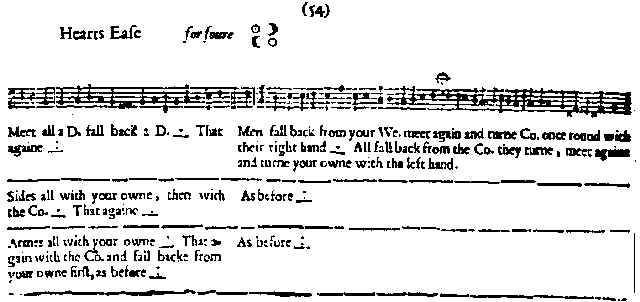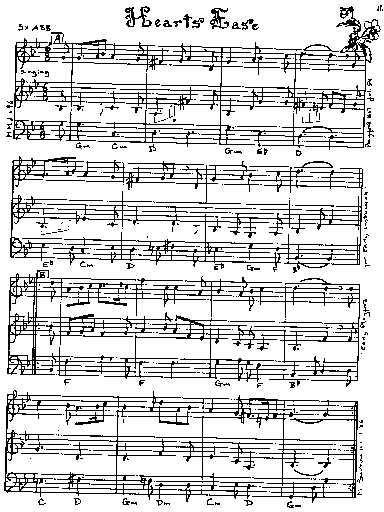
[ This article appeared in volume 2 of the Letter of Dance. ]
Hearts Ease, a country dance from Playford's The English Dancing Master, is included in many SCA groups' dance repertoires. There are differing interpretations of Playford's descriptions, depending on which group you learn the dance from. Some stay strictly with Playford's directions; others use Cecil Sharp's reconstruction (circa 1916). Interestingly, the variations are on the straight-forward part of the descriptions, and not on the more obtuse sections which seem open to interpretation.
The following figure shows the dance, as given by Playford.

[ Download full-size image in gif or pdf format. ]
First verse: Double forward and back with your partner, twice. Sharp's reconstruction is to double forward and back with your partner, then double forward and back with your contrary. This parallels the way the siding and arming is done. However, in the rest of the dance, Playford clearly states when you are to dance with your contrary, and does not say to do so here.
Second verse: Given the way we usually do siding, there is only enough time in the music to do "Sides with your own, then with the contrary". Perhaps the "That again" was a mistake made when typesetting this part -- "Sides with your own, that again with the Contrary" describes what I have always seen done here.
The only way I can imagine siding as given here would be to do one single forward and one back instead of doubles. Or, this could be done like a hey, siding past your partner, then your contrary, and so on back to places. But both of these take great liberties with what we usually define siding to be.
Third verse: (Right) arms with your partner, then (left) with your contrary. But does "fall back from your owne, as before" describe a dance step, or is is just a note to get the dancers moving in the right direction for the chorus? If Playford felt that the dancers needed such instruction after arming with their contrary, why was it not necessary after siding with the contrary? This makes me suspicious that the siding description might not be a typo, after all.
Chorus: "Men fall back from your We.....All fall back from the contrary" Our group dances this as stated: first the men (only) back away from their women, later all dancers back away from their contraries.
In Sharp's reconstruction, all back away from their own the first time, and all from their contraries the second time. This does give a lovely symmetry to the figure, but assumes that even though Playford only describes the men's steps, he meant that everyone should move. I don't agree, since Playford clearly makes a distinction between the men falling back alone, and all falling back.
Differing reconstructions of Playford's dances aren't necessarily wrong; but when working from SCA dance manuals, I have found it very useful to have a copy of Playford's "English Dancing Master" to refer back to. You can see if someone has reinterpreted an obscure description, if they introduced extra steps, or if they couldn't figure out the original at all and invented something from scratch. For Cecil Sharp's reconstructions, "The Playford Ball: 103 Early English Country Dances" (available from the Country Dance and Song Society) is a good book to work from; instructions for each dance are accompanied by a facsimile of the original directions.
[Marshall Barron's arrangement of the music is included below; as usual, my thanks to her for letting us copy it. Go out and get her books -- they're mightily useful..-- Justin.]

Webbed by Gregory Blount of Isenfir (Greg Lindahl) (lindahl@pbm.com)